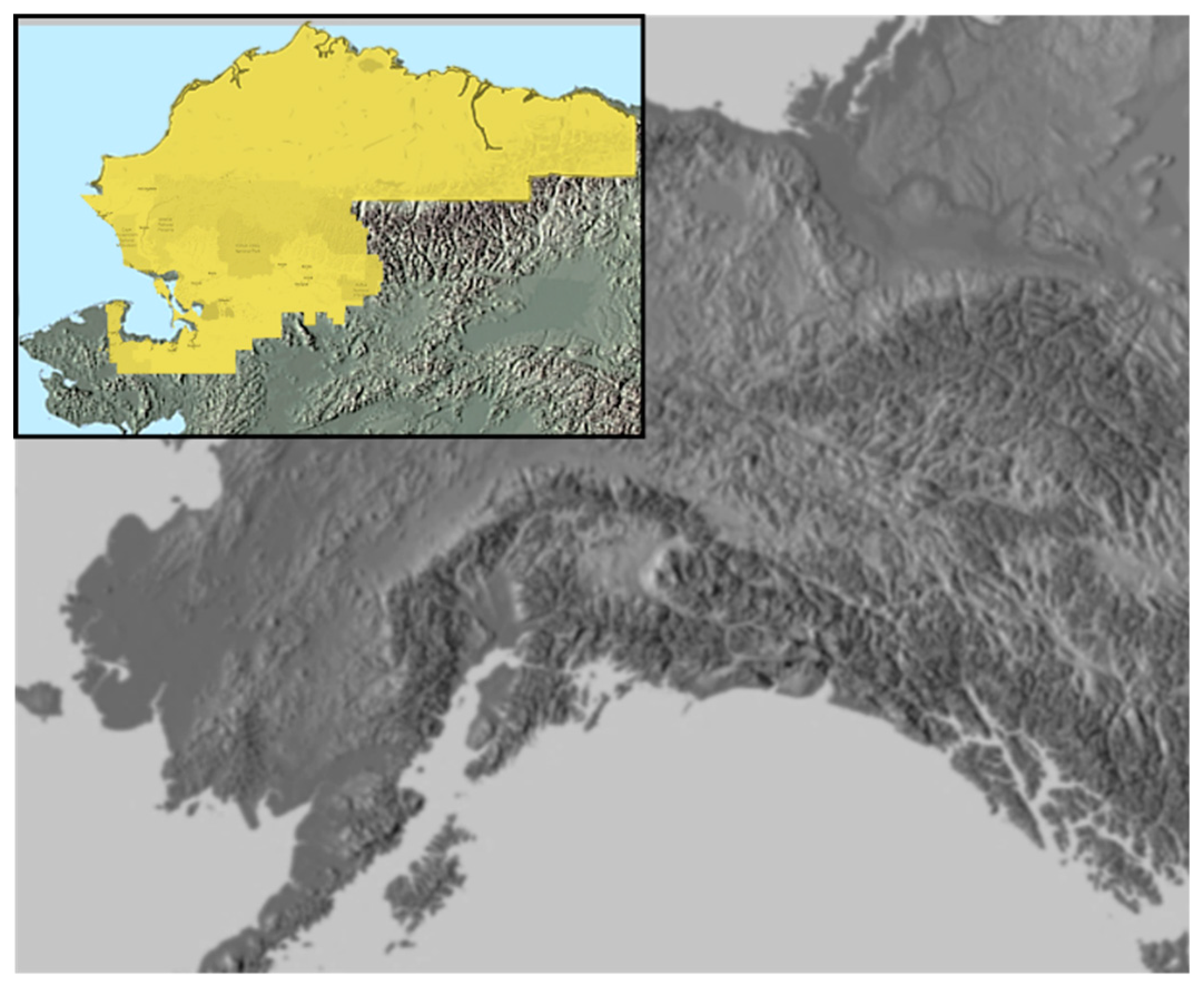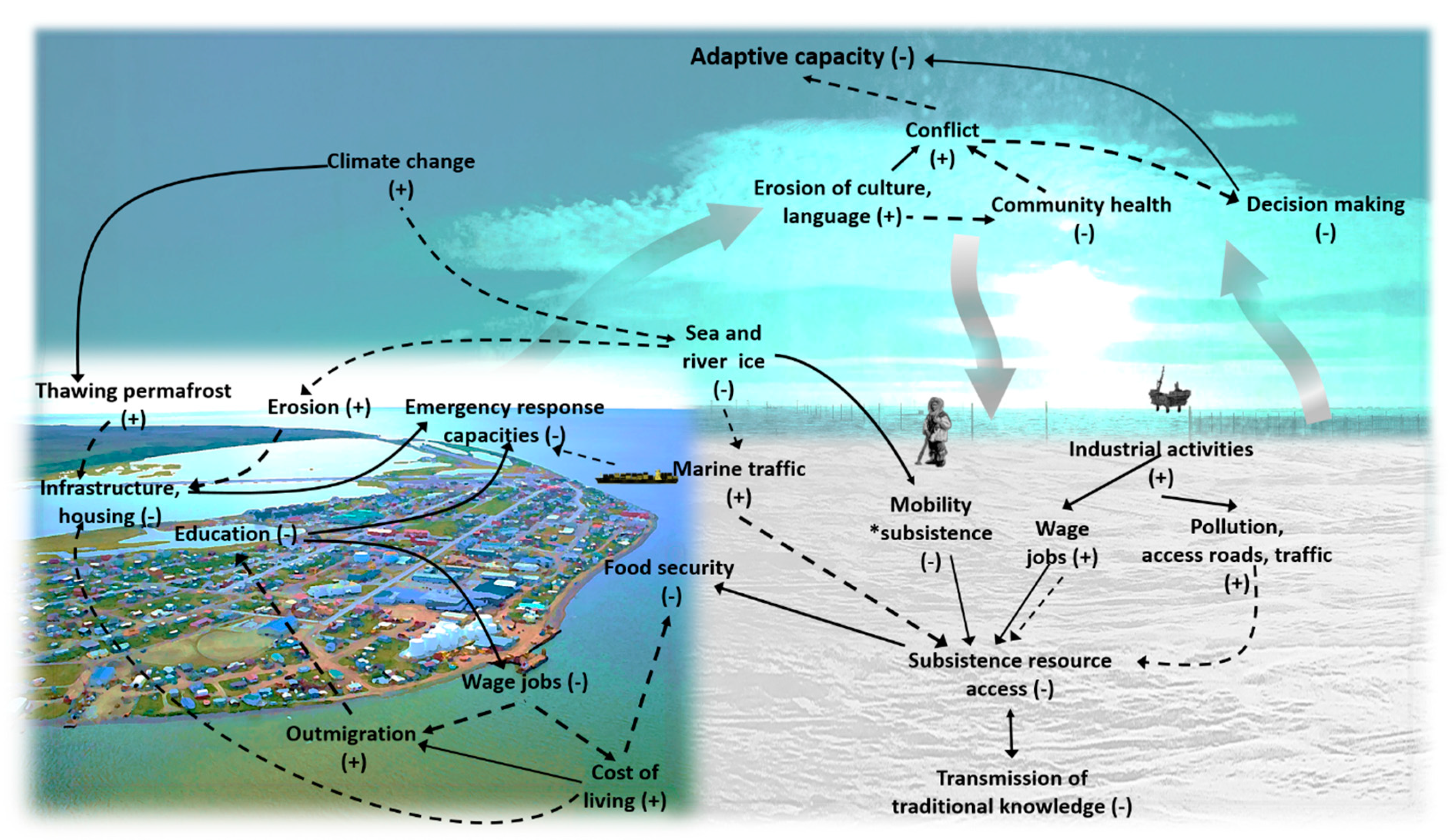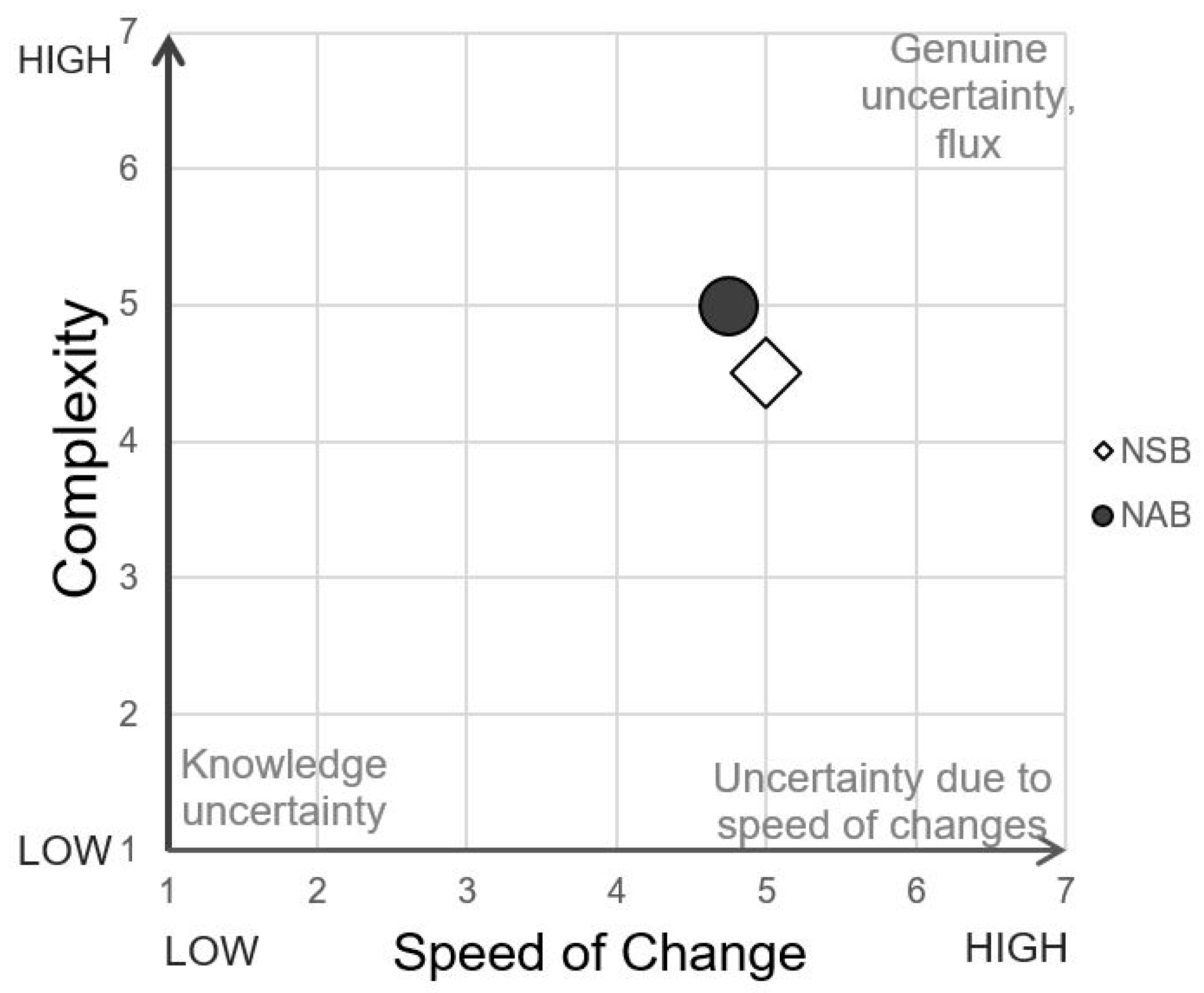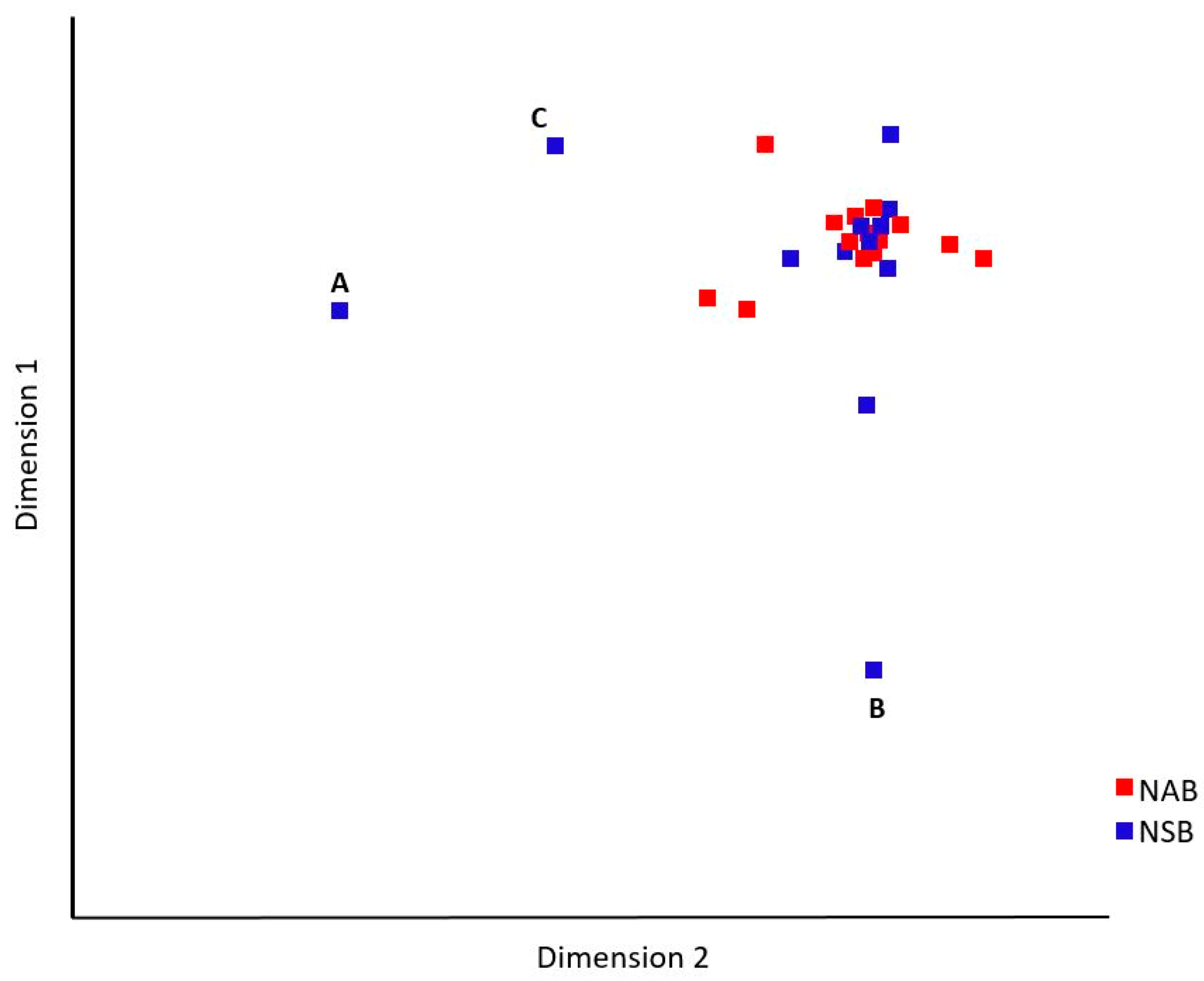Risks Without Borders: A Cultural Consensus Model of Risks to Sustainability in Rapidly Changing Social–Ecological Systems
Abstract
1. Introduction
1.1. Research Objectives and Questions
- (1)
- To what extent do the boroughs share similar views about the speed and complexity of changes that impact their social–ecological systems?
- We rely on workshop results about risks and a cross-impact analysis of uncertainties in our stakeholders’ decision environment [12] to answer this question.
- (2)
- To what extent do the two boroughs have shared beliefs about which risks threaten the sustainability of their communities the most?
1.2. Conceptual Framework
1.3. Study Area
2. Methods
2.1. Participants
2.2. Survey Instrument
3. RESULTS
3.1. Northern Alaska Social–Ecological System: Speed and Complexity of Changes
3.2. A Cultural Consensus View of Risks
3.3. Summary Results
4. Discussion and Conclusions
Supplementary Materials
Author Contributions
Funding
Acknowledgments
Conflicts of Interest
References and Notes
- Raynolds, M.K.; Walker, D.A.; Ambrosius, K.J.; Brown, J.; Everett, K.R.; Kanevskiy, M.; Kofinas, G.P.; Romanovsky, V.E.; Shur, Y.; Webber, P.J. Cumulative geoecological effects of 62 years of infrastructure and climate change in ice-rich permafrost landscapes, Prudhoe Bay Oilfield, Alaska. Glob. Chang. Biol. 2014, 20, 1211–1224. [Google Scholar] [CrossRef] [PubMed]
- Kittel, T.G.; Baker, B.B.; Higgins, J.V.; Haney, J.C. Climate vulnerability of ecosystems and landscapes on Alaska’s North Slope. Reg. Environ. Chang. 2011, 11, 249–264. [Google Scholar] [CrossRef]
- ArcticCouncil. Arctic Resilience Interim Report 2013; Stockholm Environment Institute and Stockholm Resilience Centre: Stockholm, Sweden, 2013. [Google Scholar]
- IPCC. Climate Change 2007: Synthesis Report. Contribution of Working Groups I, II and III to the Fourth Assessment Report of the Intergovernmental Panel on Climate Change; Intergovernmental Panel on Climate Change: Geneva, Switzerland, 2007; p. 104. Available online: https://www.ipcc.ch/report/ar4/syr/ (accessed on 18 January 2020).
- Blair, B.; Lovecraft, A.L.; Kofinas, G.P. Meeting institutional criteria for social resilience: A nested risk system model. Ecol. Soc. 2014, 19, 36. [Google Scholar] [CrossRef]
- Larsen, J.N.; Fondahl, G. Arctic Human Development Report: Regional Processes and Global Linkages; Nordic Council of Ministers: Copenhagen, Denmark, 2015. [Google Scholar]
- Larsen, J.N.; Fondahl, G.; Schweitzer, P. Arctic Social Indicators: A Follow-Up to the Arctic Human Development Report; Nordic Council of Ministers: Copenhagen, Denmark, 2010. [Google Scholar]
- Young, O.R. Sugaring off: Enduring insights from long-term research on environmental governance. Int. Environ. Agreem. Politics Law Econ. 2013, 13, 87–105. [Google Scholar] [CrossRef]
- Conway, D.; Nicholls, R.J.; Brown, S.; Tebboth, M.G.; Adger, W.N.; Ahmad, B.; Biemans, H.; Crick, F.; Lutz, A.F.; De Campos, R.S. The need for bottom-up assessments of climate risks and adaptation in climate-sensitive regions. Nat. Clim. Chang. 2019, 9, 503–511. [Google Scholar] [CrossRef]
- Ostrom, E. Governing the Commons: The Evolution of Institutions for Collective Action; Cambridge University Press: Cambridge, UK, 1990. [Google Scholar]
- Lovell, C.; Mandondo, A.; Moriarty, P. The question of scale in integrated natural resource management. Conserv. Ecol. 2002, 5, 25. [Google Scholar] [CrossRef]
- Lindgren, M.; Bandhold, H. Scenario Planning-Revised and Updated: The Link Between Future and Strategy; Springer: Berlin/Heidelberg, Germany, 2009. [Google Scholar]
- Romney, A.K.; Weller, S.C.; Batchelder, W.H. Culture as consensus: A theory of culture and informant accuracy. Am. Anthropol. 1986, 88, 313–338. [Google Scholar] [CrossRef]
- Weller, S.C. Cultural consensus theory: Applications and frequently asked questions. Field Methods 2007, 19, 339–368. [Google Scholar] [CrossRef]
- Abbott, J. Understanding and managing the unknown: The nature of uncertainty in planning. J. Plan. Educ. Res. 2005, 24, 237–251. [Google Scholar] [CrossRef]
- Fath, B.; Dean, C.; Katzmair, H. Navigating the adaptive cycle: An approach to managing the resilience of social systems. Ecol. Soc. 2015, 20, 24. [Google Scholar] [CrossRef]
- Holling, C.S. Understanding the complexity of economic, ecological, and social systems. Ecosystems 2001, 4, 390–405. [Google Scholar] [CrossRef]
- Chapin, F.S., III; Kofinas, G.P.; Folke, C.; Chapin, M.C. Principles of Ecosystem Stewardship: Resilience-Based Natural Resource Management in a Changing World; Springer Science & Business Media: Berlin/Heidelberg, Germany, 2009. [Google Scholar]
- Armitage, D. Adaptive capacity and community-based natural resource management. Environ. Manag. 2005, 35, 703–715. [Google Scholar] [CrossRef] [PubMed]
- Holling, C.S.; Gunderson, L.H.; Peterson, G.D. Sustainability and panarchies. In Panarchy: Understanding Transformations in Human and Natural Systems; Gunderson, L.H., Holling, C.S., Eds.; Island Press: Washington, DC, USA, 2002; pp. 63–103. [Google Scholar]
- Folke, C.; Carpenter, S.; Elmqvist, T.; Gunderson, L.; Holling, C.S.; Walker, B. Resilience and sustainable development: Building adaptive capacity in a world of transformations. AMBIO J. Hum. Environ. 2002, 31, 437–440. [Google Scholar] [CrossRef] [PubMed]
- Chapin, F.S., III; Carpenter, S.R.; Kofinas, G.P.; Folke, C.; Abel, N.; Clark, W.C.; Olsson, P.; Smith, D.M.S.; Walker, B.; Young, O.R. Ecosystem stewardship: Sustainability strategies for a rapidly changing planet. Trends Ecol. Evol. 2010, 25, 241–249. [Google Scholar] [CrossRef]
- Galaz, V.; Olsson, P.; Hahn, T.; Folke, C.; Svedin, U. The problem of fit among biophysical systems, environmental and resource regimes, and broader governance systems: Insights and emerging challenges. In Institutions and Environmental Change Principal Findings, Applications, and Research Frontiers; Young, O.R., Schroeder, H., King, L.A., Eds.; MIT Press: Cambridge, MA, USA, 2008; pp. 147–182. [Google Scholar]
- Cash, D.; Adger, W.N.; Berkes, F.; Garden, P.; Lebel, L.; Olsson, P.; Pritchard, L.; Young, O. Scale and cross-scale dynamics: Governance and information in a multilevel world. Ecol. Soc. 2006, 11, 8. [Google Scholar] [CrossRef]
- Adger, W.N. Vulnerability. Glob. Environ. Chang. 2006, 16, 268–281. [Google Scholar] [CrossRef]
- Berkes, F.; Folke, C. Linking social and ecological systems for resilience and sustainability. In Linking Sociological and Ecological Systems: Management Practices and Social Mechanisms for Building Resilience; Berkes, F., Folke, C., Eds.; Cambridge University Press: Cambridge, UK, 1998; pp. 1–25. [Google Scholar]
- Ostrom, E. A diagnostic approach for going beyond panaceas. Proc. Natl. Acad. Sci. USA 2007, 104, 15181–15187. [Google Scholar] [CrossRef]
- Colding, J.; Barthel, S. Exploring the social-ecological systems discourse 20 years later. Ecol. Soc. 2019, 24, 2. [Google Scholar] [CrossRef]
- Bennett, N.J.; Blythe, J.; Tyler, S.; Ban, N.C. Communities and change in the anthropocene: Understanding social-ecological vulnerability and planning adaptations to multiple interacting exposures. Reg. Environ. Chang. 2016, 16, 907–926. [Google Scholar] [CrossRef]
- Turner, B.L.; Kasperson, R.E.; Matson, P.A.; McCarthy, J.J.; Corell, R.W.; Christensen, L.; Eckley, N.; Kasperson, J.X.; Luers, A.; Martello, M.L. A framework for vulnerability analysis in sustainability science. Proc. Natl. Acad. Sci. USA 2003, 100, 8074–8079. [Google Scholar] [CrossRef]
- Adger, W.N. Social and ecological resilience: Are they related? Prog. Hum. Geogr. 2000, 24, 347–364. [Google Scholar] [CrossRef]
- Adger, W.N.; Hughes, T.P.; Folke, C.; Carpenter, S.R.; Rockström, J. Social-ecological resilience to coastal disasters. Science 2005, 309, 1036–1039. [Google Scholar] [CrossRef] [PubMed]
- Plummer, R.; Armitage, D. Integrating perspectives on adaptive capacity and environmental governance. In Adaptive Capacity and Environmental Governance; Springer: Berlin/Heidelberg, Germany, 2010; pp. 1–19. [Google Scholar]
- Walker, B.; Gunderson, L.; Kinzig, A.; Folke, C.; Carpenter, S.; Schultz, L. A handful of heuristics and some propositions for understanding resilience in social-ecological systems. Ecol. Soc. 2006, 11, 13. [Google Scholar] [CrossRef]
- Lebel, L.; Grothmann, T.; Siebenhüner, B. The role of social learning in adaptiveness: Insights from water management. Int. Environ. Agreem. Politics Law Econ. 2010, 10, 333–353. [Google Scholar] [CrossRef]
- Adger, W.N.; Dessai, S.; Goulden, M.; Hulme, M.; Lorenzoni, I.; Nelson, D.R.; Naess, L.O.; Wolf, J.; Wreford, A. Are there social limits to adaptation to climate change? Clim. Chang. 2009, 93, 335–354. [Google Scholar] [CrossRef]
- Young, O.R.; Gasser, L. The Institutional Dimensions of Environmental Change: Fit, Interplay, and Scale; MIT Press: Cambridge, MA, USA, 2002. [Google Scholar]
- Cornell, S.; Kalt, J.P. Sovereignty and nation-building: The development challenge in Indian country today. Am. Indian Cult. Res. J. 1998, 22, 187–214. [Google Scholar] [CrossRef]
- Haley, S. Institutional assets for negotiating the terms of development: Indigenous collective action and oil in Ecuador and Alaska. Econ. Dev. Cult. Chang. 2004, 53, 191–213. [Google Scholar] [CrossRef]
- Oakerson, R.J. Reciprocity: A bottom-up view of political development. In Rethinking Institutional Analysis and Development: Issues, Alternatives, and Choices; Ostrom, V., Feeny, D., Picht, H., Eds.; Institute for Contemporary Studies Press: San Francisco, CA, USA, 1993; pp. 141–158. [Google Scholar]
- Ostrom, V.; Feeny, D.; Picht, H. Rethinking Institutional Analysis and Development: Issues, Alternatives, and Choices; Institute for Contemporary Studies Press: San Francisco, CA, USA, 1993. [Google Scholar]
- Wynne, S. Institutional Resources for Development among the Kgaladi of Bostwana. In Rethinking Institutional Analysis and Development: Issues, Alternatives, and Choices; Ostrom, V., Feeny, D., Picht, H., Eds.; Institute for Contemporary Studies Press: San Francisco, USA, 1988; pp. 213–246. [Google Scholar]
- Dinan, T. Projected increases in hurricane damage in the United States: The role of climate change and coastal development. Ecol. Econ. 2017, 138, 186–198. [Google Scholar] [CrossRef]
- Arctic Monitoring and Assessment Programme (AMAP). Snow, Water, Ice and Permafrost. Summary for Policy-Makers; Arctic Monitoring and Assessment Programme (AMAP): Oslo, Norway, 2017. [Google Scholar]
- Moon, T.A.; Overeem, I.; Druckenmiller, M.; Holland, M.; Huntington, H.; Kling, G.; Lovecraft, A.L.; Miller, G.; Scambos, T.; Schädel, C. The expanding footprint of rapid Arctic change. Earths Future 2019, 7, 212–218. [Google Scholar] [CrossRef]
- NSB. North Slope Borough 2015 Economic Profile & Census Report. 2015. Available online: http://www.north-slope.org/assets/images/uploads/NSB_Economic_Profile_and_Census_Report_2015_FINAL.pdf (accessed on 17 February 2020).
- NAB. Northwest Arctic Borough: About. Available online: https://www.nwabor.org/about/ (accessed on 17 February 2020).
- Barnhardt, R.; Kawagley, O.A. Indigenous knowledge systems and Alaska Native ways of knowing. Anthropol. Educ. Q. 2005, 36, 8–23. [Google Scholar] [CrossRef]
- Communities in Arctic Alaska. Northern Alaska Scenarios Project Report: Creating Healthy, Sustainable Communities in Arctic Alaska; Lovecraft, A.L., Fresco, N., Cost, D., Blair, B., Eds.; University of Alaska Fairbanks: Fairbanks, AK, USA, 2017; Available online: https://www.searcharcticscience.org/files/page/documents/28065/nasp_report_2017_small.pdf (accessed on 18 February 2020).
- Hopson, E. Official Position Paper: North Slope Borough Re: Proposed Ad Valorem Tax on Oil Properties A Statement of Policy. Eben Hopson Memorial Archives. 1973. Available online: http://old.ebenhopson.com/papers/1973/AdValoremPosition.html (accessed on 17 February 2020).
- Nobel, J. America’s Most ‘Toxics-Releasing’ Facility Is Not Where You’d Think. Available online: https://www.nationalgeographic.com/news/2018/02/most-toxic-town-us-kotzebue-alaska-red-dog-mine/ (accessed on 18 February 2020).
- Ahtuangaruak, R. Broken promises: The future of Arctic development and elevating the voices of those most affected by it–Alaska Natives. Politics Groups Identities 2015, 3, 673–677. [Google Scholar] [CrossRef]
- Case, D.S.; Voluck, D.A. Alaska Natives and American Laws; University of Alaska Press: College, AK, USA, 2012. [Google Scholar]
- Kimmel, M. Sovereigns, not stakeholders: An Alaskan study in fate control. Yearb. Polar Law Online 2014, 6, 318–339. [Google Scholar] [CrossRef]
- Anonymous Interviewee A. Northern Alaska Community Sustainability Interviews. Halas, G. (University of Alaska Fairbanks, USA), Blair, B. (University of Alaska Fairbanks, USA), Interviewers. 2016. Transcript on file with first author Blair, B.
- Kruse, J.A.; White, R.G.; Epstein, H.E.; Archie, B.; Berman, M.; Braund, S.R.; Chapin, F.S.; Charlie, J.; Daniel, C.J.; Eamer, J.; et al. Modeling sustainability of arctic communities: An interdisciplinary collaboration of researchers and local knowledge holders. Ecosystems 2004, 7, 815–828. [Google Scholar] [CrossRef]
- Thoman, R.; Walsh, J.E. Alaska’s Changing Environment: Documenting Alaska’s Physical and Biological Changes Through Observations; McFarland, H.R., Ed.; International Arctic Research Center, University of Alaska Fairbanks: Fairbanks, AK, USA, 2019. [Google Scholar]
- Anonymous Interviewee B. Northern Alaska Community Sustainability Interviews. Halas, G. (University of Alaska Fairbanks, USA), Blair, B. (University of Alaska Fairbanks, USA), Interviewers. 2016. Transcript on file with first author Blair, B.
- Anonymous Interviewee C. Northern Alaska Community Sustainability Interviews. Halas, G. (University of Alaska Fairbanks, USA), Blair, B. (University of Alaska Fairbanks, USA), Interviewers. 2016. Transcript on file with first author Blair, B.
- Bronen, R.; Chapin, F.S. Adaptive governance and institutional strategies for climate-induced community relocations in Alaska. Proc. Natl. Acad. Sci. USA 2013, 110, 9320–9325. [Google Scholar] [CrossRef] [PubMed]
- Dressler, W.W.; Borges, C.D.; Balieiro, M.C.; Dos Santos, J.E. Measuring cultural consonance: Examples with special reference to measurement theory in anthropology. Field Methods 2005, 17, 331–355. [Google Scholar] [CrossRef]
- Corbin, J.M.; Strauss, A. Grounded theory research: Procedures, canons, and evaluative criteria. Qual. Sociol. 1990, 13, 3–21. [Google Scholar] [CrossRef]
- Carothers, C.; Brown, C.; Moerlein, K.J.; López, J.A.; Andersen, D.B.; Retherford, B. Measuring perceptions of climate change in northern Alaska: Pairing ethnography with cultural consensus analysis. Ecol. Soc. 2014, 19, 27. [Google Scholar] [CrossRef]
- Borgatti, S.P.; Everett, M.G.; Freeman, L.C. Ucinet for Windows: Software for Social Network Analysis; Analytic Technologies: Lexington, KY, USA, 2002. [Google Scholar]
- ATLAS.ti, v.8.0, Scientific Software Development-GmbH: Berlin, Germany.
- Hopping, K.; Yangzong, C.; Klein, J. Local knowledge production, transmission, and the importance of village leaders in a network of Tibetan pastoralists coping with environmental change. Ecol. Soc. 2016, 21, 25. [Google Scholar] [CrossRef]
- Borgatti, S. Elicitation Techniques for Cultural Domain Analysis in Ethnographer’s Toolkit; Schensul, J., Ed.; Sage: Newbury Park, CA, USA, 1998. [Google Scholar]
- Borgatti, S.P. Multidimensional Scaling; Analytic Technologies: Lexington, KY, USA, 1997. [Google Scholar]
- Stacey, R.D. Strategic Management and Organisational Dynamics: The Challenge of Complexity to Ways of Thinking About Organisations; Pearson Education: London, UK, 2007. [Google Scholar]
- Tschakert, P.; Dietrich, K.; Tamminga, K.; Prins, E.; Shaffer, J.; Liwenga, E.; Asiedu, A. Learning and envisioning under climatic uncertainty: An African experience. Environ. Plan. A 2014, 46, 1049–1068. [Google Scholar] [CrossRef]
- Blair, B.; Lovecraft, A.; Hum, R. The Disaster Chronotope: Spatial and Temporal Learning in Governance of Extreme Events. In Governance of Risk, Hazards and Disasters: Trends in Theory and Practice; Forino, G., Bonati, S., Calandra, L.M., Eds.; Routledge: Abingdon, UK, 2018; pp. 43–64. [Google Scholar]
- Trainor, S.F. Adaptation. In Adaptation Actions for a Changing Arctic: Perspectives from the Bering-Chukchi-Beaufort Region; Arctic Monitoring and Assessment Programme (AMAP): Oslo, Norway, 2017. [Google Scholar]
- Niemeyer, S. A defence of (deliberative) democracy in the anthropocene. Ethical Perspect. 2014, 21, 15–45. [Google Scholar]
- Ayala, J.; Bautista, P.; Pajaro, M.; Raquino, M.; Watts, P. Sustainable development of Philippine coastal resources: Subsidiarity in ethnoecology through inclusive participatory education. Int. Rev. Educ. 2016, 62, 161–185. [Google Scholar] [CrossRef]
- Naves, L.C.; Simeone, W.E.; Lowe, M.E.; Valentine, E.M.; Stickwan, G.; Brady, J. Cultural Consensus on Salmon Fisheries and Ecology in the Copper River, Alaska. Arctic 2015, 68, 210–222. [Google Scholar] [CrossRef][Green Version]
- Grunblatt, J.; Alessa, L. Role of perception in determining adaptive capacity: Communities adapting to environmental change. Sustain. Sci. 2017, 12, 3–13. [Google Scholar] [CrossRef]
- Grant, K.L.; Miller, M.L. A cultural consensus analysis of marine ecological knowledge in the Solomon Islands. SPC Tradit. Mar. Resour. Manag. Knowl. Inf. Bull. 2004, 17, 3–13. [Google Scholar]
- Lebel, L.; Anderies, J.; Campbell, B.; Folke, C.; Hatfield-Dodds, S.; Hughes, T.; Wilson, J. Governance and the capacity to manage resilience in regional social-ecological systems. Ecol. Soc. 2006, 11, 19. [Google Scholar] [CrossRef]




| Risk Items Evaluated for CCA | CCA Final Results: Is Item Viewed as a Risk to Community Sustainability? | All N = 26 | NSB n = 12 | NAB n = 14 |
|---|---|---|---|---|
| Less snow in winter | Yes | 25 | 10 | 14 |
| Shallow river and lake waters | Yes | 24 | 10 | 14 |
| Thawing permafrost | Yes | 26 | 11 | 14 |
| More wildfires | Yes | 20 | 7 | 13 |
| Vegetation change | Yes | 22 | 9 | 12 |
| Later fall freeze-up | Yes | 25 | 12 | 12 |
| Earlier spring breakup | Yes | 25 | 11 | 14 |
| Health and health care issues | Yes | 23 | 9 | 13 |
| Environmental problems | Yes | 26 | 11 | 14 |
| Education issues: Formal schooling | Yes | 25 | 9 | 14 |
| Education issues: Transmission of traditional knowledge | Yes | 27 | 11 | 14 |
| Ineffective decision making | Yes | 25 | 10 | 13 |
| Industrial activities | Yes | 24 | 8 | 13 |
| Risks to culture | Yes | 25 | 10 | 15 |
© 2020 by the authors. Licensee MDPI, Basel, Switzerland. This article is an open access article distributed under the terms and conditions of the Creative Commons Attribution (CC BY) license (http://creativecommons.org/licenses/by/4.0/).
Share and Cite
Blair, B.; Lovecraft, A.L. Risks Without Borders: A Cultural Consensus Model of Risks to Sustainability in Rapidly Changing Social–Ecological Systems. Sustainability 2020, 12, 2446. https://doi.org/10.3390/su12062446
Blair B, Lovecraft AL. Risks Without Borders: A Cultural Consensus Model of Risks to Sustainability in Rapidly Changing Social–Ecological Systems. Sustainability. 2020; 12(6):2446. https://doi.org/10.3390/su12062446
Chicago/Turabian StyleBlair, Berill, and Amy L. Lovecraft. 2020. "Risks Without Borders: A Cultural Consensus Model of Risks to Sustainability in Rapidly Changing Social–Ecological Systems" Sustainability 12, no. 6: 2446. https://doi.org/10.3390/su12062446
APA StyleBlair, B., & Lovecraft, A. L. (2020). Risks Without Borders: A Cultural Consensus Model of Risks to Sustainability in Rapidly Changing Social–Ecological Systems. Sustainability, 12(6), 2446. https://doi.org/10.3390/su12062446




